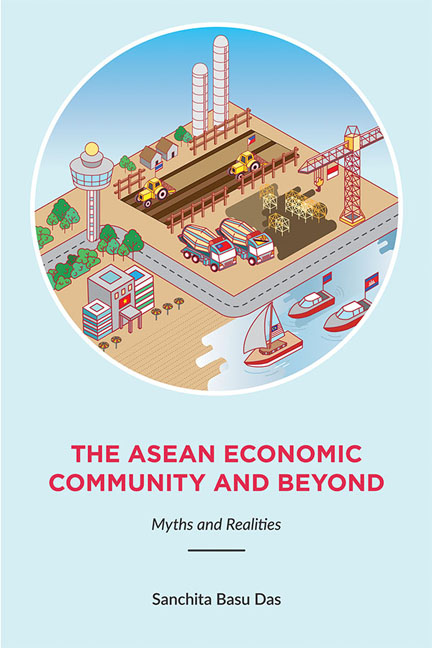Book contents
- Frontmatter
- Dedication
- Contents
- Foreword
- Acknowledgements
- Abbreviations
- 1 Introduction: The ASEAN Economic Community and Beyond
- I THE ASEAN ECONOMIC COMMUNITY (AEC)
- II BEYOND THE ASEAN ECONOMIC COMMUNITY
- III AN ASEAN PERSPECTIVE OF REGIONAL CONNECTIVITY
- 18 Promoting Asia's Infrastructure for Regional Trade and Investment
- 19 Addressing Infrastructure Financing in Asia
- 20 APEC and ASEAN Connectivity: Areas of Mutual Interest and Prospects of Cooperation
- 21 China's Three-pronged Strategy on Regional Connectivity
- 22 Can the China-led AIIB Support the ASEAN Connectivity Master Plan?
- Appendix: Summary of the Trans-pacific Partnership Agreement
- Index
- About the Author
21 - China's Three-pronged Strategy on Regional Connectivity
from III - AN ASEAN PERSPECTIVE OF REGIONAL CONNECTIVITY
Published online by Cambridge University Press: 19 May 2017
- Frontmatter
- Dedication
- Contents
- Foreword
- Acknowledgements
- Abbreviations
- 1 Introduction: The ASEAN Economic Community and Beyond
- I THE ASEAN ECONOMIC COMMUNITY (AEC)
- II BEYOND THE ASEAN ECONOMIC COMMUNITY
- III AN ASEAN PERSPECTIVE OF REGIONAL CONNECTIVITY
- 18 Promoting Asia's Infrastructure for Regional Trade and Investment
- 19 Addressing Infrastructure Financing in Asia
- 20 APEC and ASEAN Connectivity: Areas of Mutual Interest and Prospects of Cooperation
- 21 China's Three-pronged Strategy on Regional Connectivity
- 22 Can the China-led AIIB Support the ASEAN Connectivity Master Plan?
- Appendix: Summary of the Trans-pacific Partnership Agreement
- Index
- About the Author
Summary
For the last year, China has been occupying headlines about improving connectivity in the region. This can be viewed as a three-pronged strategy to counterbalance the United States’ 2011 announcements of a “Pivot to Asia” and the launch of the negotiations of the Trans-Pacific Partnership. The three-pronged strategies could be seen as: (a) Disclosing the physical routes — China announced its “One Belt, One Road” initiative in 2013, referring to the New Silk Road Economic Belt and the 21st Century Maritime Silk Road. The initiative underlines Chinese initiative to share its development experience, leverage on its development assistance and to export its technologies and production capacity. (b) Financing the routes — The second aspect relates to the instruments through which China aims to finance these plans. A Silk Road Fund worth US$40 billion has been set up, together with two proposed multilateral lending banks — the Asian Infrastructure Investment Bank (AIIB) and the BRICS New Development Bank (NDB). (c) Feasibility of the routes — The third aspect is to make the announced physical routes viable by increasing the volume of trade and investment along the routes. This can be observed during the 2014 APEC Summit when China championed the idea of a Free Trade Area of the Asia-Pacific (FTAAP) among APEC countries.
China's role in promoting the AIIB agenda could be seen as a pathway to: match the shift of global economic weight from the West to the East with commensurate influence in the governance of multilateral development banks; explore avenues to invest China's foreign exchange reserves which are safe and can provide returns higher than U.S. treasuries; and satisfy the infrastructure gap in the region so as to support future economic growth and stability.
INTRODUCTION
Since the BRICS summit in July 2014 in Brazil, when five developing member countries announced the establishment of the New Development Bank (NDB), there has been widespread media coverage on regional connectivity. One major step forward was in October 2014, when twentyone Asian countries signed a Memorandum of Understanding (MOU) on the establishment of the Asian Infrastructure Investment Bank (AIIB) to fund infrastructure projects. The issue gained momentum during the Asia-Pacific Economic Cooperation (APEC) Summit in Beijing, as well as at the G-20 Summit in Brisbane, both held in November 2014.
- Type
- Chapter
- Information
- The ASEAN Economic Community and BeyondMyths and Realities, pp. 235 - 247Publisher: ISEAS–Yusof Ishak InstitutePrint publication year: 2015

